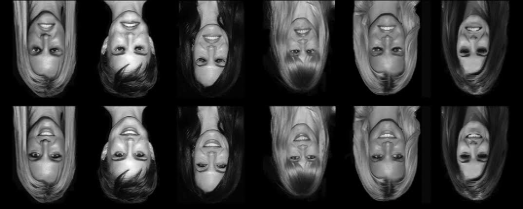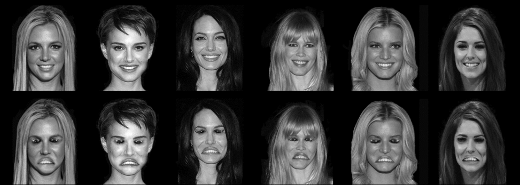
This side up: brain responses to faces’ expressions are affected by their orientation
Posted on 24 December 2013

A new article from York scientists in the leading journal Psychological Science shows that the regions of the brain that process facial expressions are sensitive faces’ orientations. The Thatcher illusion, in which the eyes and mouth of a face are turned upside down. This is barely noticeable when the face is seen upside down as in the above image, but it leads to the perception of a rather grotesque expression when viewed in an upright face (scroll down to see the same picture upside down). In the MRI scanner, these images were used to investigate the brain mechanisms behind the effect, in turn shedding light on how expressions are processed by our brains. The study shows that brain activity in a region already thought to be involved in facial expression perception (the Superior Temporal Sulcus - STS) is sensitive to the change between normal and “thatcherized” faces, only when they are upright (i.e., in conditions which produce the obvious grotesque perceptual change) and not in inverted faces. This add support to the idea that the STS is critical for processing facial expressions and elegantly shows that its role is specialised for processing whole faces in their normal configuration and doesn’t, for example, simply combine information from different parts of the face without regard to their organisation.
The work was carried out at the York Neuroimaging Centre by PhD student Lilia Psalta (a graduate of our MSc Cognitive Neuroscience programme) supervised by Professor Tim Andrews and working with Professors Andy Young and Peter Thompson. Peter Thompson first described the Thatcher illusion in 1980 (using the eponymous then-Prime Minister as an example), but this is one of the first studies to investigate its basis in the brain using fMRI.

Lilia Psalta, Andrew W. Young, Peter Thompson, and Timothy J. Andrews
The authors examined the neural underpinnings of the Thatcher illusion -- an illusion used to examine how faces are processed -- by collecting fMRI data while participants viewed two pictures of the same face or different faces. The faces were normal or Thatcherized (eyes and mouth inverted), and the photos were presented upright or upside down. The observed differences in the activity of the superior temporal sulcus, which is involved in processing facial expressions, in response to changes from normal to Thatcherized upright -- but not inverted -- faces provide evidence that neural regions involved in the processing of facial expression are sensitive to orientation.
